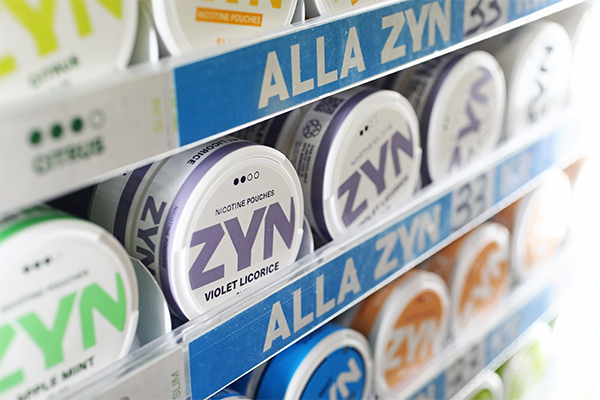
A new study reveals that major brands of oral nicotine pouches (ONP) contain significant amounts of artificial sweeteners, making them not only easier to consume but potentially more appealing to young users.
Adding sweeteners is a widely used strategy to mask irritating and bitter tasting chemicals in foods and medicines. But Duke University School of Medicine set out to explore whether the intensely sweet compounds – acesulfame-k (ace-k) and sucralose, for example, are 200-700 times sweeter than table sugar – might influence nicotine use.
In studies in mice, the answer was clear: the sweeteners increased nicotine consumption and researchers found that some higher-strength nicotine varieties contained greater amounts of sweeteners.
“Sweet flavors make these products more appealing—especially to young people who might be trying them for the first time."
- Sairam V. Jabba, PhD, toxicologist and researcher Duke University School of Medicine
“Artificial sweeteners added to oral nicotine pouches have similar masking effects, reducing the bitterness of nicotine and leading to increased consumption,” said lead study author Sairam V. Jabba, PhD, a toxicologist, and senior research scientist in the Department of Anesthesiology at Duke School of Medicine. “The mouse behavioral experiments in our study indicate that added sweeteners are strong determinants of product consumption.”
The study published in Nicotine and Tobacco Research and co-authored by Sven-Eric Jordt, PhD, an associate professor in the Department of Anesthesiology at Duke, found that the sweetener acesulfame-K was present in popular oral nicotine pouches On! and Zyn —even in varieties labeled as unflavored—at levels ranging from 0.3 to 0.9 mg per pouch.

Velo pouches, another popular brand, contained sucralose, and sucralose levels increased with nicotine strength, ranging from approximately 0.6 to 1.2 mg per pouch.
The findings raise concern about the role of oral nicotine pouches in nicotine addiction, particularly among adolescents and young adults who have a much higher preference for sweetened products than adults. The federal minimum age to buy tobacco products, including Zyn, is 21 years old.
Scientists are still learning about the short- and long-term health effects of using nicotine pouches. However, using nicotine during adolescence can harm parts of the brain that control attention, learning, mood, and impulse control.
Since entering the U.S. market in 2016, oral nicotine pouches have surged in popularity yet haven’t knocked cigarettes from the top spot among nicotine products. Many ONP brands are made by major tobacco companies. The small pouches—placed between the upper lip and gum—contain powdered nicotine, artificial sweeteners, and flavorings like citrus, mint, cinnamon, and coffee, but no tobacco.
There’s little chemical difference between tobacco-derived nicotine and synthetic nicotine: both types are addictive, according to the U.S. Centers for Disease Control and Prevention.
Sweetness Affects Nicotine Consumption in Mice
Researchers examined the role of sweeteners in oral nicotine consumption by comparing the consumption of commercial oral nicotine pouch extracts between wild type, or normal, mice and mice deficient in the sweet taste receptor. Mice incapable of tasting sweetness due to the genetic deletion of the sweet taste receptor (Tas1r2) consumed less of the nicotine pouch extracts than normal mice, suggesting that sweetness enhances palatability.
While wild-type mice tolerated nicotine pouches with high nicotine and sweetener levels, Tas1r2-deficint mice showed stronger aversion, reinforcing the idea that sweetness masks nicotine’s harshness.
“Regulators need to take a closer look at the sweetness in tobacco products, especially when it comes from artificial sweeteners,” Jabba said. “Sweeteners and sweet-associated flavors make these products more appealing—especially to young people who might be trying them for the first time. By treating sweetness as a key part of a product’s flavor, regulators can help reduce its appeal and lower the chances of new users picking up the habit.”
Funding for the study was provided by the National Institute of Drug Abuse of the National Institutes of Health (R56DA055996 and R01DA060884) and the Center for Tobacco Products of the U.S. Food and Drug Administration.
Additional authors include Peter Silinski, PhD in the Department of Chemistry at Duke University and Wenyi Ouyang and Alicia Y. Yang in the Department of Anesthesiology at Duke University School of Medicine.